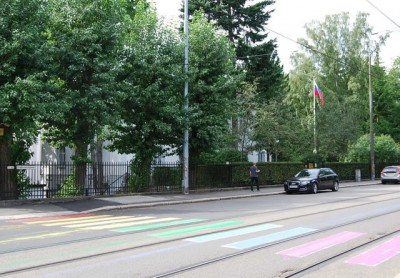More false mobile telephone base stations, capable of monitoring mobile phone communication, were likely in operation around Oslo late last autumn, reports newspaper Aftenposten, and may have targeted the Russian, French and British embassies. Norwegian government offices and several other embassies have been identified as surveillance targets earlier, but now all the suspected base stations apparently have been dismantled.

Aftenposten has been running a series of stories since mid-December, reporting on testing by the newspaper’s own reporters that indicated illegal surveillance of mobile telephones. The surveillance was made possible by the false base stations also known as “IMSI catchers” or “stingrays,” signals from which were picked up by encrypted mobile phones used by Aftenposten.
The highly sophisticated and portable spying equipment was believed to have been placed near the Office of the Prime Minister and Defense Department offices at the Akershus Fortress, around the Norwegian Parliament and at both ends of Parkveien behind the Royal Palace, the street on or near which the Israeli, US and other embassies are located along with the prime minister’s residence.
Aftenposten later reported that suspicious signals picked up by its reporters’ phones also indicated the placement of more “stingrays” around the Aker Brygge and Tjuvholmen commercial and residential complexes, one of the capital’s most affluent areas and viewed as Norway’s finance hub. Some analysts claimed that whoever placed the equipment, backed by either government or commercial interests, was likely attracted by Norway’s wealth and the relative political power that comes with it.
More suspicious signals in Skillebekk
On Monday evening, Aftenposten’s website reported that more signals from suspected spying equipment had been picked up in the Skillebekk and Frogner areas around Drammensveien, Frederik Stangs Gate, Skarpsnogata and Gabels Gate. That’s the area where the Russian, British, French and several other embassies are located.
Both the Americans and the Russians had quickly been suspected of being behind the false base stations, based largely on their track record of earlier surveillance and spying scandals and their technical capability. Now they appear as targets themselves, with a spokesman for the Russian Embassy telling Aftenposten that it lacked the “necessary technical capacity” to maintain secure communications around its buildings on Drammensveien. “As we see it, that’s mainly the responsibility of the Norwegian authorities,” Andrey Kulikov, press attaché and second secretary of the Russian Federation, told Aftenposten. He added that “we have no information about IMSI-catchers” around the embassy.
He called Aftenposten’s information “very interesting,” while the press attaché at the French Embassy didn’t want to comment. Few embassies have, except the Israeli Embassy which expressed concern over who may be spying on them.
Questions raised over Norwegian response
Aftenposten has raised questions over the lack of communications security and why the Norwegian authorities have failed to address the issue of mobile phone surveillance or investigate the presence of false base stations earlier. Aftenposten wrote that its initial reports were made available to “all relevant” Norwegian officials including the the national security agency NSM prior to publication. NSM conducted some tests of its own in mid-December, just before Aftenposten published its first story, and confirmed its own findings of suspicious signals. Other authorities including the police intelligence unit PST initially suggested there was no point, though, in trying to track down the actual equipment because it could be placed inside private property, was small and highly portable. They later thought differently and meetings have been held in an effort to better coordinate efforts to boost security.
In other countries, including the US, the police themselves have been accused of using IMSI-catchers to help track down criminals. Aftenposten has reported that it has no reason to believe Norwegian government authorities or the local police are behind those suspected of being placed around Oslo and possibly other Norwegian cities.
It now appears that whoever was behind the equipment has since dismantled it. No signals have been picked up recently in Skillebekk, Frogner or the other downtown areas where they flourished last fall and as late as mid-December. “Someone pressed the ‘off’ button,” Aftenposten wrote on Monday. Justice Minister Anders Anundsen was due to address the issue in Parliament. He has denied that the false base stations can be part of any legal surveillance put in place by Norwegian agencies, and has branded them as “extremely serious, completely unacceptable and illegal.”
newsinenglish.no/Nina Berglund

